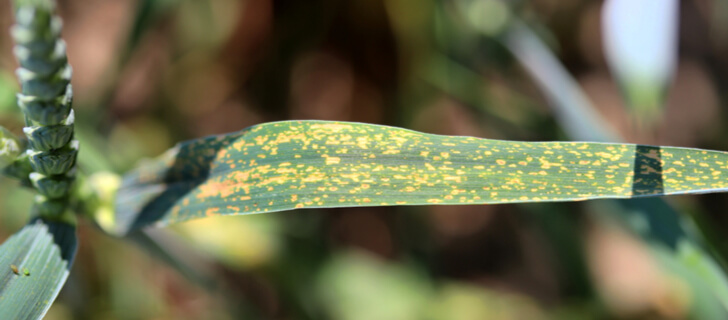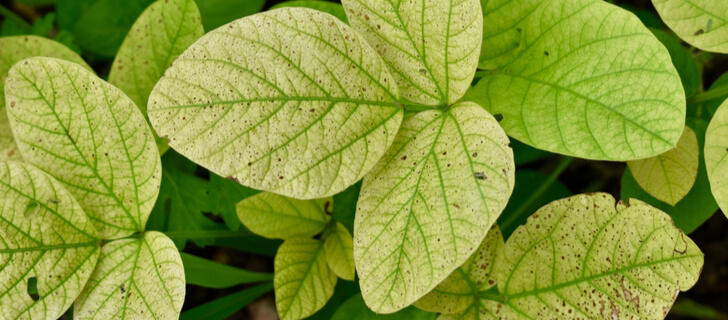
Nutrient deficiency is the main cause of stunted plant growth often leading to complete crop losses. Nonetheless, crop starvation for micro or macronutrients can be diagnosed visually, and prompt identification will save the affected yields.
Frequent visual symptoms of nutrient deficiency in plants comprise malformation, discoloration, dotting, crinkling, and even necrosis. When a visual examination is not feasible, satellite monitoring is another convenient way of preliminary nutrient deficiency diagnostics. Manifestations of different elements’ undersupply can be similar, so it is critical to understand which one is lacking and provide it on time.
What Is A Nutrient Deficiency In Plants?
The term implies limited access to vital chemical elements causing deviations in crop development. It happens because vegetation needs certain chemical elements at each phenological stage in certain volumes. For proper vegetation development, the chemicals and their volumes should be balanced correctly.What Nutrients Do Crops Need And Why?
There are primary (major) and secondary (minor) chemical elements vital for crops. We refer to a nutrient deficiency if vegetation is starving for any of them.The primary chemical elements are nitrogen (N), phosphorus (P), and potassium (K), alongside calcium (Ca). sulfur (S) or magnesium (Mg). These chemicals support ultimate vegetation needs. The biggest volumes are included in the fertilizers of the N-P-K group. Besides, vegetation requires minor volumes of copper (Cu), iron (Fe), molybdenum (Mo), zinc (Zn), boron (B), manganese (Mn), etc.

What Causes A Nutrient Deficiency In Plants
Vegetation’s nutrient starvation frequently happens due to a lack of chemicals in poor soils. However, crops may be unable to absorb the required chemicals even when the soils are rich. In particular, it happens due to soil salinization, a serious cause of nutrient deficiency in plants.Besides, the ability to uptake nutrients depends on the vegetation state and crop production environment. Thus, nutrient transportation will be impaired due to:
- damaged or undeveloped roots;
- insufficient or excessive irrigation;
- poor drainage;
- improper pH rates.
How To Identify A Nutrient Deficiency In Plants?
Detection starts with field inspection for crop growth failures. Further, one needs to exclude abnormal conditions with similar signs and provide the crop with the corresponding element.Plant nutrient deficiency identification comprises the following methods:
- visual examination to exclude pest attacks and crop diseases due to biotic stresses;
- consideration of a possible impact of unfavorable growth environment (abiotic stresses);
- in-field and remote crop monitoring for the signs of nutrient deficiency;
- soil testing for chemical content, pH and electrical conductivity (EC), salinity, etc.

What Are The Symptoms Of A Nutrient Deficiency In Plants?
Visually, vegetation’s nutrient starvation is diagnosed through slow development and discolored or malformed foliage. Nitrogen starvation is the most common nutrient deficiency in plants, but they may lack several chemicals at a time.Primary and secondary chemical elements are macro and micronutrients correspondingly. Their differentiating feature is the volumes that crops need. Each element plays a specific role in crop growth at a certain stage. Let’s consider what happens due to this or that element’s undersupplies.
Plant Symptoms Of A Nutrient Deficiency In Macroelements
If vegetation suffers from a poor supply of N, P, K, and Mg, it can be understood through visual symptoms in mature foliage. A lack of Ca or S manifests first on newer leaves.Nitrogen (N)
Because N provides green vegetation color thanks to the chlorophyll pigment, the main signs of nutrient deficiency in plants are pale-green newer and yellowish mature leaves. Unchecked early signs develop into poor secondary shooting, purple stem striping, crop thinning, or stunting. A V-shaped yellowing or glossy kernels are specific signs of N deficiency in corn. Rice manifests poor canopy production and tillering.Phosphorus (P)
Crops need phosphorus to build proteins, buds, seeds, and blooms. A typical signal of phosphorus nutrient deficiency in plants is bronzish, purplish, or reddish coloring in the lower parts of mature foliage. Sometimes, severe starvation results in brownish dotting and necrosis. P deficiency in grain crops (e.g., wheat) results in poor tillering.Potassium (K)
Using K, crops resist diseases and make sugars to synthesize proteins, duplicate cells, or develop roots. Potassium nutrient deficiency in plants reveals irreparable leaf-margin yellowing, rotting, scorching, crinkling, curling, shrinking, and necrosis of midribs.Sulfur (S)
Sulfuric nutrition promotes nitrogen use and the creation of chlorophyll and proteins. Pale-green to dark-yellow new foliage is a common plant nutrient deficiency symptom because of S undersupply. In some crops (e.g., canola), foliage may roll and turn purplish.Plant nutrient deficiencies for N or S are diagnosed by similar signs of yellowing, so it is critical to notice if the problem starts on newer or mature leaves.
Calcium (Ca)
This chemical assists in forming new cells. For this reason, weak growth points are a distinguishing symptom of Ca nutrient deficiency in a plant:- tip burns;
- malformation of newly-grown parts;
- blossom-end rots;
- flower drops;
- small fruits.
Magnesium (Mg)
Alongside other elements, crops require Mg for chlorophyll. Thus, Mg undersupply also affects crop coloration. Frequent signs of Mg nutrient deficiency are deep-green leaf veins, yellowish sections (later necrotic), small and dropping lower leaves.How long does it take for the plant to start recovering from a nutrient deficiency?
Recovery is supposed to start in nearly a week. Vegetation’s ability to recover depends on its techniques to survive under nutrient deficiency and starvation persistence – the damage is irrevocable at times.

Signs Of Nutrient Deficiencies In Plants For Microelements
Vegetation utilizes microelements in minor doses, yet even such amounts still matter for healthy growth. Their lack can be understood through visual symptoms starting on new or mature leaves. Suffering new foliage is typical for Fe, Zn, B, Mn, or Cu undersupplies. Signs of insufficient amounts of Mo begin on mature leaves.Copper (Cu)
This element boosts multiple vegetation activities, from photosynthesis to breathing. Cu starvation is clear through yellowing and necrosis, foliage wilting, poor flowering, impaired development, etc. A recognizable sign is blue-greenish foliage in some types of crops (e.g., vegetables and corn).Cu is responsible for seed production, so its lack will result in small grains leading to yield loss.
Iron (Fe)
Vegetation uses Fe to make enzymes and proteins, so its lack will impact growth. Pale-green, yellowish or whitish leaves with necrotic dots signal Fe nutrient deficiency in plants. Upper foliage whitening because of Fe undersupply is typical for cotton.Molybdenum (Mo)
Mo participates in converting nitrogen to ammonia (nitrogen fixation), so small doses of this chemical in fields are vital. Mo nutrient deficiency in crops is diagnosed through yellowish margins and pale-green centers of mature leaves. Molybdenum-starving soybeans are pale-green. Uncorrected damage progresses to necrosis.Because Mo is critical for nitrogen fixation, its undersupply causes N deficiency in crops.
Zinc (Zn)
Alongside other elements, zinc boosts vegetation growth. Crops signal Zn deficiency through:- small, chlorotic, bronze, or spotty newer foliage;
- impaired shooting;
- yellowing.
Manganese (Mn)
Vegetation requires Mn supplies for multiple purposes, e.g., cell duplication, building chlorophyll, or breathing. Effects of a nutrient deficiency in plants for Mn comprise a tiny size, poor rooting and shooting, yellowish fragments in-between veins, and dark or necrotic dots.Boron (B)
Supplied as borate, B is utilized for cell duplication, proper water use, and movement of sugars. A recognizable sign of boron starvation is the so-called “witches’ broom” due to abnormal side shooting. Such a bushy or “rosette” appearance is common for alfalfa or carinata. Other signs are deformed, tiny, fragile, and sometimes rusty newer leaves. Mature foliage turns shiny and deep-green.EOSDA Crop Monitoring
Access high-resolution satellite images to ensure effective fields management!
REQUEST A DEMO
TRY NOW!
How To Prevent And Treat Nutrient Deficiency In Plants
Leaf spraying or adding the lacking chemical to the rhizome are typical options. If absorption of the required nutrient is impossible due to certain field conditions, the issue should be diagnosed via soil testing and accordingly addressed.Applying fertilizer mixers may lead to undesirably high concentrations of other components. To avoid nutrient imbalance and toxicity, it is preferable to practice one-element (mono-nutrient) supplies.
Prevention and treatment for nutrient deficiency in crops depending on element
| Nutrient | Prevention & treatment measures |
|---|---|
| Nitrogen (N) | Application of N-containing chemicals is a short-term industrial method of nitrogen fixation. Use organic matter, semi-liquid animal and green manure, blood meal, N-fixing crops in plant nutrient deficiency long-term solutions. |
| Phosphorus (P) | Replenish phosphorus undersupply with bone meal, superphosphate, or phosphoric acid. |
| Potassium (K) | Compensate for K deficiency with sulfate/muriate of potash, potassium nitrate, or potassium hydroxide. Take wood ash, seaweed, kelp, or chicken manure in organic farming. |
| Calcium (Ca) | Use calcium nitrate, lime, gypsum, or crushed eggshells as sources of Ca for crops. |
| Magnesium (Mg) | Spray crop leaves with Epsom salts for a plant nutrient deficiency short-term solution. Add dolomite (dolomitic limestone) to enrich the earth with Mg in the long run. Organic additives are composted turkey or cow manure. |
| Sulfur (S) | Choose sulfate of potash, kieserite, or magnesium/ammonium sulfate. Mind the presence of other elements in the compounds. Composted mushrooms are a popular method to address an S deficiency in organic farming. |
| Iron (Fe) | Correct Fe nutrient deficiency in plants by spraying damaged leaves with diluted ferrous sulfate for quick results. Iron chelate compounds (EDDHSA or EDTA) help solve the problem for a longer time. |
| Zinc (Zn) | Treat the damaged leaves with zinc sulfate/chelate. |
| Boron (B) | Fix B nutrient deficiency with diluted borax or boric acid. |
| Copper (Cu) | Opt for copper sulfate dilution as a leaf spray. |
| Manganese (Mn) | Get manganese sulfate/chelate for plant leaves treatment. |
| Molybdenum (Mo) | Feed your crops’ leaves with molybdenum-containing additives. |
Satellite Technologies For Plant Nutrient Deficiency Identification And Treatment
Despite satellite technologies cannot detect the exact type of nutrient deficiency, they can definitely tell if the crop is experiencing stress. Using various vegetation indices on our platform, you will easily spot that stress and start analyzing the cause. As timely identification of crop nutrient deficiency is critical, especially in the case of macronutrient starvation, EOSDA Crop Monitoring acts as a preventive alarm.
When the problem is identified, it’s time to fix it by an application of a lacking fertilizer. This process is often tricky as everyone wants to reduce fertilizer waste. That’s when a variable rate fertilizer application turns handy. EOSDA Crop Monitoring productivity mapping divides the field into specific zones, where each zone requires a different amount of additional chemical elements. Such zoning precisely treats each field area depending on its needs, which saves resources. Moreover, it reduces environmental pollution, making food production and agriculture more sustainable.

Weather forecasting is another important feature of EOSDA Crop Monitoring that facilitates efficient treatment for nutrient deficiency in plants. Knowing the upcoming weather, you can avoid undesired fertilizer leaching and choose the most favorable day for fertilization with the best results.
EOSDA Crop Monitoring can provide many other valuable features. Reach out to our sales team at [email protected] for more details and expert consultation. All in all, nutrient deficiency threatens crops and negatively impacts their growth. If nutrient starvation persists, there’s a risk of yield losses. So, it’s critical to understand the nutrient deficiency in plants promptly and address it with adequate supplies. Satellite-based field monitoring helps do it on time and apply fertilizers rationally.





